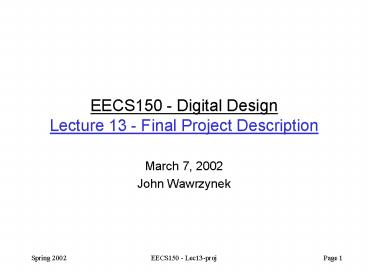EECS150 Digital Design Lecture 13 Final Project Description - PowerPoint PPT Presentation
1 / 28
Title:
EECS150 Digital Design Lecture 13 Final Project Description
Description:
Everyone will design, debug, and demonstrate a Music Synthesizer ... tone quality or 'color' Different instruments have different timbres. ... – PowerPoint PPT presentation
Number of Views:70
Avg rating:3.0/5.0
Title: EECS150 Digital Design Lecture 13 Final Project Description
1
EECS150 - Digital DesignLecture 13 - Final
Project Description
- March 7, 2002
- John Wawrzynek
2
Project
- Everyone will design, debug, and demonstrate a
Music Synthesizer - Operation based on principle of waveform
synthesis or sampling. - Sounds from recordings of real musical
instruments are stored in memory then
pitch-shifted and played back in response to note
commands. - 1 or 2 partners/group
3
Digital Waveforms
- In digital systems waveforms are represented as a
series of numbers, rather than a voltage or
current, as in analog systems. - Example sound waveform
- Sound can be produced by sending series of
numbers to Digital to Analog converter, then to
Amplifier, then to speaker. - In principle any sound can be produced.
Sampling rate 31.25KHz 16-bits per sample
4
Interfaces
- MIDI Musical Instrument Digital Interface.
- Commands are sent from a keyboard (or computer)
to control the synthesizer. - Waveforms are stored in the ROM (read only
memory). - Monophonic one voice at a time.
5
Theory of Sound and Music
- Air vibrating in the frequency range of 20Hz to
20KHz is perceived as sound. - The three important characteristics of perceived
sound are - loudness (relates to amplitude)
- pitch (relates to frequency)
- timbre (relates to shape)
- Human hearing is approximately logarithmic in
perceiving loudness and pitch - we perceive the loudness as being prop to the log
of the sound wave amplitude
6
Timbre
- tone quality or color
- Different instruments have different timbres.
- We perceive timbre based on how a note begins,
repeats, and ends. - For many instruments a simple model can be used
to represent the shape of the waveform. - Attack, sustain, release (decay)
- Works best for driven instruments woodwinds,
brass, bowed strings. - Pluck and struck instruments dont have the
sustain
picture
7
Pitch
- Middle C has frequency of 261.63Hz.
- MIDI encoding of 60
- High C (an octave above middle C) has frequency
523.25Hz - MIDI encoding of 72
- Other tones can be produced by multiplying and
dividing the frequency by factors of 12th root of
2.
- Pitch
- 12 semi-tones form the chromatic scale of the
western scale. - To move from one up to the next
- freqnext freq 12th root of 2.
- After 12 such multiplications we will have
doubled the freq and reached the octave. - Most people can detect pitch differences as small
as a few hundreds of a semi-tone (or a few times
the 1200th root of 2)!
8
(No Transcript)
9
Playing Notes
- ROM used to store notes has limited capacity.
- For notes with sustain portion, would like to
vary note duration
10
Pitch Shifting
11
Pitch Shifting
12
Linear Interpolation
13
ROM (EEPROM) Layout
- One stored note per instrument is never enough.
- Timbre varies from note to note over the range of
the instrument. - ROM holds directory with one entry per MIDI note
number. - Entry holds pointer to note template and step
size. - Note step sizes are precomputed (synthesizer does
not need to do 12th root of 2 calculation. - One instrument per ROM (might change this later).
14
Directory Entry Layout
- 20-bit template pointer
- 12 bits of step size
15
Template Layout
16
Instrument Template Files
- We will provide you with template files and a
program for converting these to EPROM format. - We also have programs for taking instrument
samples from standard file formats and converting
them to our template format. You are encouraged
to generate your own template files and EPROMs. - We might extend the format (and project) to allow
for more than one instrument per EPROM. - Switch among the instruments either through dip
switches or MIDI commands.
17
High-level Block Diagram
FSM and datapath for each block.
This is only a suggestion. Your organization is
up to you.
18
Checkpoints
- 3/11 UART Design and Test
- 3/18 ROM Interfacing
- 3/25 Recess
- 4/1 MIDI Interface
- 4/1 Audio Stage
- 4/8 Monotone Notes
- 4/15 Notes of Arbitrary Frequency
- 4/22 Velocity Sensitivity
- 4/29 Spare
- 5/6 Final Checkoff
- Your are strongly suggested to work ahead.
- These are only minimum requirements.
- Completion of checkpoints are part of your
project grade. - Project spec document online today.
- All checkpoint write-ups available in next couple
days (in draft form).
19
Extra Credit
- Early Final Checkoff.
- 1 week or more
- Low CLB Count.
- low quantified later
- Interpolation
- add linear interpolation for sample lookup
- Polyphony.
- The ability to play multiple keys at once
- Velocity Sensitive Template Lookup.
- Index templates not only on key number but also
velocity.
- Extra credit only considered for fully functional
designs. - Point assignment announced later. Usually in the
15 range.
20
(No Transcript)
21
Connections
22
(No Transcript)
23
(No Transcript)
24
Note On
25
Note off
26
Keyboard Mapping
27
(No Transcript)
28
Running Status
- The MIDI standard convention allows a transmitter
to compress the data stream by dropping status
bytes. - A command without a status byte implicitly uses
whatever status byte was most recently sent. - Therefore a keyboard can send a sequence of
note-on and note-off commands only the first of
which having a status byte. - Your synthesizer must conform to the running
status convention.









![CS3104: ?????? Principles of Digital Design [project2] floating-point number addition PowerPoint PPT Presentation](https://s3.amazonaws.com/images.powershow.com/8016500.th0.jpg?_=20160728018)





















